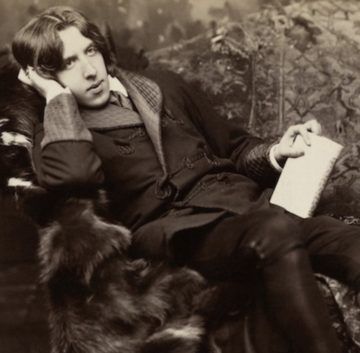Nicholas Frankel in Literary Hub:
 Oscar Wilde’s ship docked in New York Harbor on the evening of January 2, 1882, one week before he was scheduled to speak at Chickering Hall. During the crossing he had composed his first lecture, but the journalists who swarmed onto the ship as it lay at anchor off Staten Island were more interested in Wilde himself than in the theories he had come to expound. “His outer garment was a long ulster trimmed with two kinds of fur, which reached almost to his feet,” reported the New York World; “he wore patent-leather shoes, a smoking-cap or turban, and his shirt might be termed ultra-Byronic . . . His hair flowed over his shoulders in dark-brown waves, curling slightly upwards at the ends . . . His teeth were large and regular, disproving a pleasing story which has gone the rounds of the English press that he has three tusks or protuberants.” His face presented “an exaggerated oval of the Italian face carried into the English type of countenance,” the World reporter continued, while his “manner of talking” was “somewhat affected . . . his great peculiarity being a rhythmical chant in which every fourth syllable is accentuated.” “The dress of the poet was not less remarkable than his face,” declared the San Francisco Chronicle, “and consisted of a short velvet coat, rose-colored necktie and dark-brown trousers . . . cut with a sublime disregard of the latest fashion.”
Oscar Wilde’s ship docked in New York Harbor on the evening of January 2, 1882, one week before he was scheduled to speak at Chickering Hall. During the crossing he had composed his first lecture, but the journalists who swarmed onto the ship as it lay at anchor off Staten Island were more interested in Wilde himself than in the theories he had come to expound. “His outer garment was a long ulster trimmed with two kinds of fur, which reached almost to his feet,” reported the New York World; “he wore patent-leather shoes, a smoking-cap or turban, and his shirt might be termed ultra-Byronic . . . His hair flowed over his shoulders in dark-brown waves, curling slightly upwards at the ends . . . His teeth were large and regular, disproving a pleasing story which has gone the rounds of the English press that he has three tusks or protuberants.” His face presented “an exaggerated oval of the Italian face carried into the English type of countenance,” the World reporter continued, while his “manner of talking” was “somewhat affected . . . his great peculiarity being a rhythmical chant in which every fourth syllable is accentuated.” “The dress of the poet was not less remarkable than his face,” declared the San Francisco Chronicle, “and consisted of a short velvet coat, rose-colored necktie and dark-brown trousers . . . cut with a sublime disregard of the latest fashion.”
Like modern tabloid journalists, they peppered him with questions both flippant and straight: what time did he get up in the morning? Did he like his eggs fried on both sides or just one? Did he trim his fingernails in the style of the Empress of Japan? Was he here to secure copyright in his play? If Wilde was thrown by this barrage of questions, he did not betray it.
More here.
